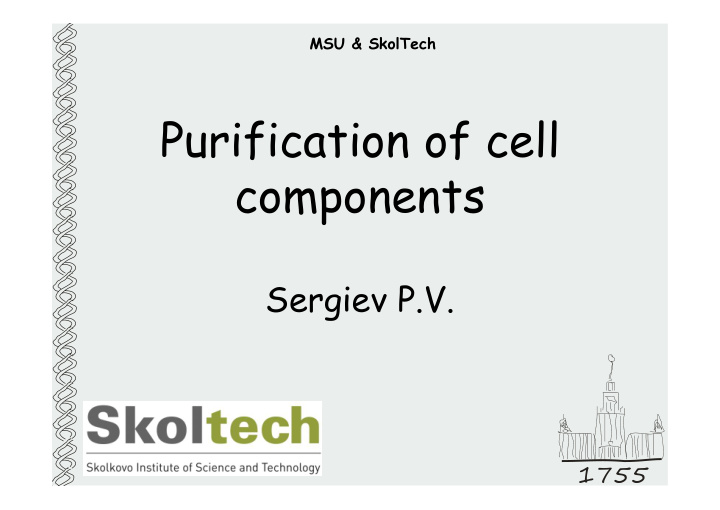



MSU & SkolTech Purification of cell components Sergiev P.V. 1755
Disintegration of samples Lysis of bacterial cells Lysozyme – breakdown of cell wall Freezing/thawing cycles Grinding with aluminum oxide Sonication Pressure drop 1755
Disintegration of samples Lysis of yeast Lyticase - cell wall breakdown Grinding in liquid nitrogen Bead beater Glass beads 1755
Disintegration of samples Lysis of mammalian cells or tissues Trypsin/EDTA separate mammalian cells Dounce homogenizer Dismembrator 1755
Centrifugation Separation of cellular components according to their density Methods of centrifugation differ in rotation speed volume of the sample arrangement of vials centrifugation media 1755
Centrifugation Table top centrifuge – the main working horse in the lab Rotation speed up to 14 000 rpm Up to 2 ml samples Fixed angle rotors Used for precipitations (Nucleic acids and proteins) and phase separation 1755
Centrifugation Medium speed preparative centrifuge Rotation speed up to 20 000 rpm Up to 1 l samples Fixed angle and swinging bucket rotors Used for cell separation, debris separation after cell lysis 1755
Centrifugation Ultracentrifuge Rotation speed up to 90 000 rpm (200 000 in some cases) 100 m l - 50 ml samples Fixed angle and swinging bucket rotors Used for separation of organelles and macromolecular complexes 1755
Centrifugation Ultracentrifuge w G= 2 r Fixed angle rotors: pelleting down macromolecules 1755
Centrifugation Ultracentrifuge w 2 u= rS 2 Dr = D S h 20,w 18 Swinging bucket rotors: Separation of macromolecular complexes by their sedimentation coefficient in a density gradient of sucrose or glycerol 1755
Centrifugation Ultracentrifuge Ribosome separation by a sucrose density centrifugation polysomes Top Bottom 1755
Chromatography General principle 1755
Chromatography Gel filtration Porous media (sephadex, sephacryl) particles bigger when pores are passing faster small particles are retraded 1755
Chromatography Hydrophobic Salt concentration 1755
Chromatography Ion exchange Salt concentration 1755
Chromatography Affinity 1755
Chromatography Affinity chromatography media Ni NTA His6 glutation GST IgG Z-domain of S. aureus protein А Protein А(G) IgG Streptavidin Biotin Specific antibodies antigenes Immobilization methods BrCN NH2 Hydroxysuccinimide NH2 Epoxyde NH2,SH Hydrazide CHO 1755
Ultrafiltration Passage through the pores 1755
Preparation of specific biopolymer type Enzymatic degradation of the unwanted polymer: DNase treatment RNase treatment Protease tratment Phenol deproteinization Ethanol precipitation of nucleic acids Trifluoroacetic acid protein precipitation 1755
Gel electrophoresis General principle - + 1755
Electrophoresis in agarose gels Application Typical gel Power supply Separation of DNA and RNA Agarose gel 50-20 000 bp non-denaturing Buffer Visualization by UV illumination Gel formation by via intercalating dye cooling the melted fluorescence agarose solution 1755
Electrophoresis in acrylamide gels Application Separation of DNA and RNA 10 – 3000 nt Usually denaturing conditions (urea) Gel formation by radical polymerization, initiator (persulfate) and catalyst (TEMED) needed Visualization by UV, radioisotope or fluorescent labeling, methylen blue staining 1755
Capillary electrophoresis Up to 96 samples at a time 1755
Southern blotting General principle DNA fragments separation Transfer to a membrane Cross-linking to the membrane Hybridization with radioactive or fluorescent probe Northern blotting – similar method for RNA detection 1755
Protein gel electrophoresis Denaturing (Laemmli) gel - pH 6.8 large pores , small conductivity high electric field Gly quick movement of proteins Proteins are concentrated pH 8.8 small pores , at the border Gly- high conductivity small electric field slow movement of proteins + 1755
Protein gel electrophoresis Denaturing (Laemmli) gel - - - - - - - - - - - SDS - - - - - - - - - - Anionic detergent (SDS) denature proteins and make them negatively charged proportional to the molecular mass of protein 1755
Protein gel electrophoresis Staining methods Coomassie, 50 ng silver nitrate 1 ng Other fluorescent dyes SYPRO Ruby 1 ng 1755
Immuno (western) blotting General principle + Protein separation Electrotransfer - Blocking the rest of membrane by BSA primary antibody binidng Secondary antibody (conjugate) binding Development by a specific reagent 1755
Immuno (western) blotting Methods for protein band visualization Alkaline phosphatase O Cl Cl O - Cl Cl Cl OH O P O O O O - Br Br Br Br Br AP NH NH NH -2H NH NH BCIP blue precipitate (NBT) Horseradish peroxidase O - NH 2 NH 2 O NH 2 O NH 2 O NH 2 O O - O - N N - NH O - O - N N - О 2 NH hv - ОН HRP O - O O O O light luminol 1755
Isoelectric focusing Separation of proteins by isoelectric (neutrality) point Alkali solution Alkali solution Ampholines small molecules with a range of isoelectric points рН рН Proteins are locating according to their isoelectric points Acidic solution Acidic solution 1755
2D gel electrophoresis Separation by charge and mass Isoelectric focusing Gel electrophoresis 1755
Differential 2D gel electrophoresis sample 1 sample 2 labeling by labeling by Су5 Су3 isoelectric focusing Laemmli electrophoresis 1755
Protein identification Matrix assisted laser desorption ionization (MALDI) + gel piece with protein sample trypsinolysis + peptides + mass spectrometry + + matrix laser impulse blows the matrix 1755
Protein identification Matrix assisted laser desorption ionization (MALDI) sample detector + + + + - time of flight (TOF) 1755
Protein identification Matrix assisted laser desorption ionization (MALDI) 4 In te n s. [a .u .] x10 8 7 8 .5 1.5 Peptide mass 90 2.5 set is unique 1 490 .7 1 54 6 .8 1 1 25 .7 1 84 9.7 characteristic of protein 1.0 it allows 1 9 29 .9 protein 6 87 .4 identification 10 96 .6 0.5 16 1 2 .7 27 35 .1 20 0 5.7 2 14 7 .8 20 9 7 .0 1 19 8 .7 17 94.7 2 2 0 1 .1 9 7 6.4 286 9.3 750 1000 1250 1500 1750 2000 2250 2500 2750 3000 1755
Recommend
More recommend